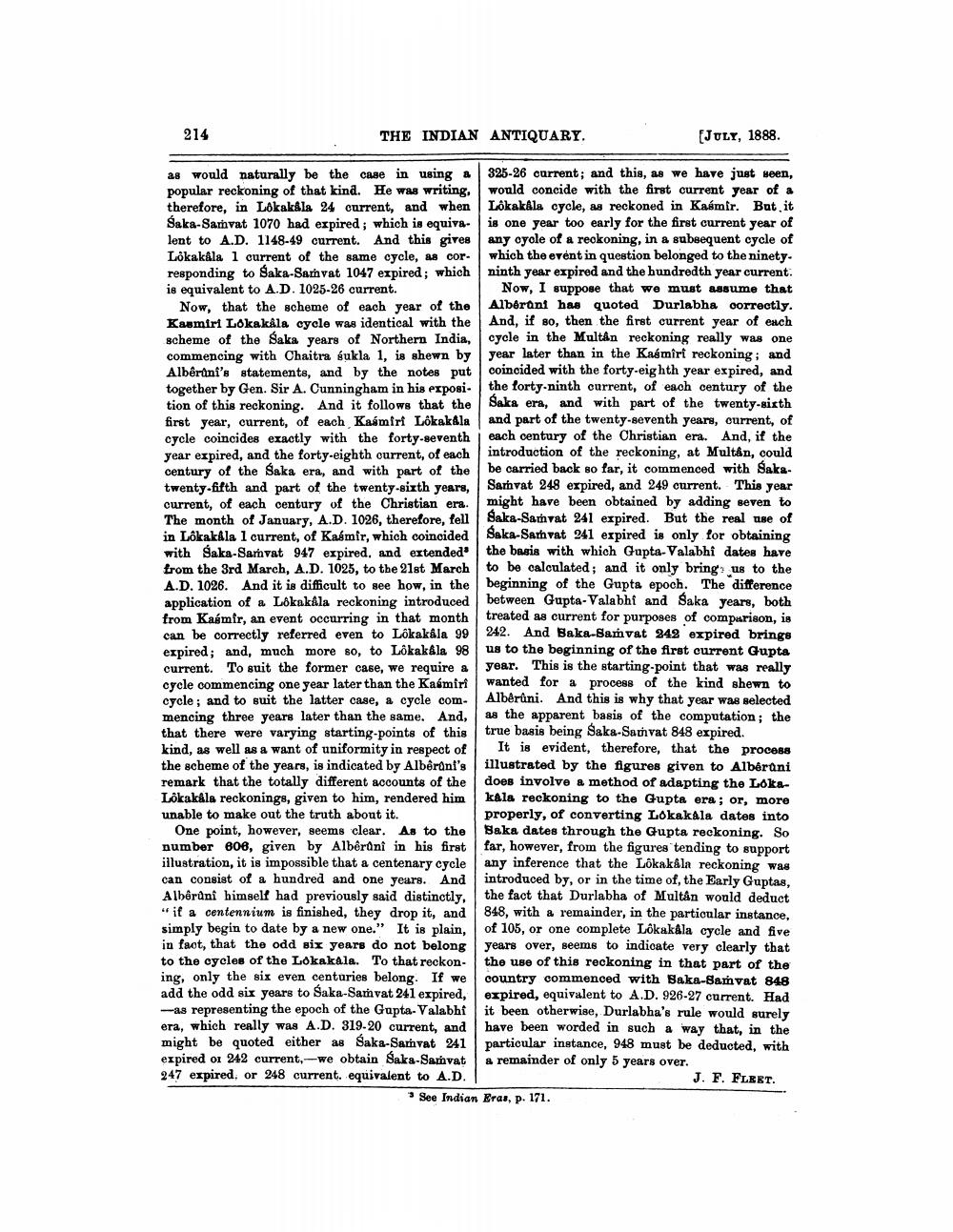________________
214
THE INDIAN ANTIQUARY.
[JULY, 1888.
as would naturally be the case in using a 325-26 current; and this, as we have just seen, popular reckoning of that kind. He was writing, would concide with the first current year of a therefore, in Lokakala 24 current, and when Lokakala cycle, as reckoned in Kasmir. But it Saka-Sarhvat 1070 had expired; which is equiva- is one year too early for the first current year of lent to A.D. 1148-49 current. And this gives any oyole of a reckoning, in a subsequent cycle of Lokakala 1 current of the same cycle, as cor- which the event in question belonged to the ninety. responding to Saka-Samvat 1047 expired; which ninth year expired and the hundredth year current: is equivalent to A.D. 1025-26 current.
Now, I suppose that we must assume that Now, that the scheme of each year of the Albertini has quoted Durlabha correctly. Kasmirt LokakAla cycle was identical with the And, if so, then the first current year of euch scheme of the Saka years of Northern India, cycle in the Multán reckoning really was one commencing with Chaitra sukla 1, is shewn by 1 year later than in the Kasmirf reckoning: and Albêrini's statements, and by the notes put coincided with the forty-eighth year expired, and together by Gen. Sir A. Cunningham in his exposi- the forty-ninth current, of each century of the tion of this reckoning. And it follows that the Saka era, and with part of the twenty-sixth first year, current, of each Kasmiri Lokakála and part of the twenty-seventh years, current, of cycle coincides exactly with the forty-seventh each century of the Christian era. And, if the year expired, and the forty-eighth current, of each introduction of the reckoning, at Multán, could century of the Saka era, and with part of the be carried back so far, it commenced with Sake. twenty-fifth and part of the twenty-sixth years, Samvat 248 expired, and 249 current. This year current, of each century of the Christian era. I might have been obtained by adding seven to The month of January, A.D. 1026, therefore, fell Saka-Samvat 241 expired. But the real tee of in Lôkakala 1 current, of Kasmir, which coincided Saka-Samvat 241 expired is only for obtaining with Saka-Sarvat 947 expired, and extended the basis with which Gupta-Valabhi dates have from the 3rd March, A.D. 1025, to the 21st March to be calculated; and it only bring us to the A.D. 1026. And it is difficult to see how, in the beginning of the Gupta epoch. The difference application of a Lókakala reckoning introduced between Gupta- Valabhi and Saka years, both from Kasmir, an event occurring in that month treated as current for purposes of comparison, is can be correctly referred even to Lokakala 99 242. And Baka-Samvat 949 expired brings expired; and, much more so, to LokakAla 98
uch more so. to Lokakala 98 us to the beginning of the first current Gupta current. To suit the former case, we require a year. This is the starting point that was really cycle oommencing one year later than the Kasmiri wanted for a process of the kind shewn to cycle; and to suit the latter case, a cycle com- Alberuni. And this is why that year was selected mencing three years later than the same. And, as the apparent basis of the computation; the that there were varying starting points of this true basis being Saka-Sauvat 848 expired. kind, as well as a want of uniformity in respect of
ant of uniformity in respect of It is evident, therefore, that the process the scheme of the years, is indicated by Albêrüni's illustrated by the figures given to Alberani remark that the totally different accounts of the does involve a method of adapting the LoksLokakala reckonings, given to him, rendered him kala reckoning to the Gupta era ; or, more unable to make out the truth about it.
properly, of converting Lokakala dates into One point, however, seems clear. As to the Saka dates through the Gupta reckoning. So number 806, given by Alberoni in his first far, however, from the figures tending to support illustration, it is impossible that a centenary cycle any inference that the Lokakala reckoning was can consist of a hundred and one years. And introduced by, or in the time of the Early Guptas, Albérůni himself had previously said distinctly, the fact that Durlabha of Multán would deduct "it a centennium is finished, they drop it, and 848, with a remainder, in the particular instance, simply begin to date by a new one." It is plain, of 105, or one complete Lókakala cycle and five in fact, that the odd six years do not belong years over, seems to indicate very clearly that to the cycles of the Lokakala. To that reckon. the use of this reckoning in that part of the ing, only the six even centuries belong. If we country commenced with Baka-samvat 848 add the odd six years to Saka-Samvat 241 expired, expired, equivalent to A.D. 926-27 current. Had -as representing the epoch of the Gupta- Valabhi it been otherwise, Durlabha's rule would surely era, which really was A.D. 319.20 current, and have been worded in such a way that, in the might be quoted either as Saka-Samvat 241 particular instance, 948 must be deducted, with expired or 242 current.--we obtain Saka-Sarvata remainder of only 5 years over. 247 expired, or 248 current. equivalent to A.D.
J. F. FLEET. * See Indian Eras, p. 171.




